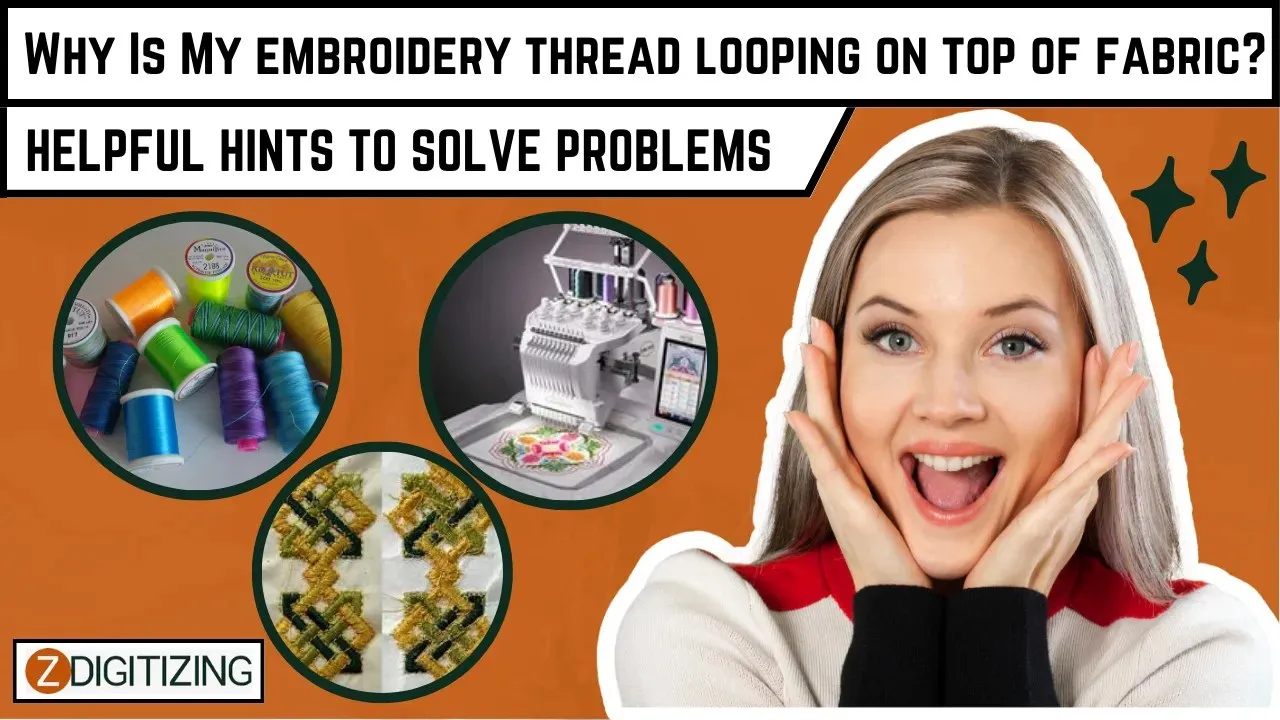



Embroidery is a delightful and creative craft that allows you to embellish fabrics with beautiful designs and patterns. However, like any artistic pursuit, embroidery can present its fair share of challenges. One common issue that embroiderers encounter is when the embroidery thread loops on top of the fabric instead of forming neat and consistent stitches. These loops, also known as thread loops or birdnesting, can be frustrating and result in a messy and uneven embroidery design. In this blog, we will explore the reasons behind why your embroidery thread is looping on top of the fabric and provide troubleshooting tips and solutions to help you achieve flawless embroidery results.
Incorrect Thread Tension
One of the primary reasons for thread looping is incorrect thread tension. Tension refers to the tightness or looseness of the thread during the stitching process. If the tension is too loose, the thread can loop and tangle on top of the fabric. On the other hand, if the tension is too tight, the fabric can pucker, and the thread can break.
Solution: Adjust the thread tension using the tension dial on your embroidery digitizing machine. Start by setting the tension to the default or recommended setting for your machine and make slight adjustments until the loops disappear. Test the tension on a scrap piece of fabric to ensure optimal results.
Improper Hooping and Stabilization
Hooping is the process of securing the fabric and stabilizer in the embroidery hoop. If the fabric is not hooped properly or if the stabilizer is not adequately supporting the fabric, the embroidery machine may struggle to form even stitches, leading to thread looping on top of the fabric.
Solution: Follow these steps for proper hooping and stabilization:
a) Hoop the fabric and stabilizer together tightly to prevent shifting during embroidery.
b) Choose the appropriate stabilizer for the fabric type. Use tear-away stabilizer for lightweight fabrics and cut-away stabilizer for heavier fabrics.
c) Ensure that the fabric is flat and smooth within the hoop, without any wrinkles or creases.
Thread Quality and Type
Using low-quality embroidery thread or the wrong type of thread can contribute to thread looping issues. Inferior thread may be more prone to tangling and breaking during embroidery. Additionally, certain thread types, such as metallic or specialty threads, may require adjustments to the embroidery machine settings to avoid looping.
Solution: Invest in high-quality embroidery thread specifically designed for machine embroidery. Check the thread's weight and compatibility with your embroidery machine before use. Metallic or specialty threads may require slower embroidery speeds and adjustments to tension and stitch settings.
Bobbin Tension
The tension of the bobbin thread can also impact the quality of the embroidery stitches. If the bobbin tension is too loose or too tight, it can lead to looping and tangling of the top thread.
Solution: Check the bobbin tension and make necessary adjustments if needed in zdigitizing. Refer to your embroidery machine's manual for instructions on adjusting bobbin tension. Remember to use the correct bobbin thread weight and type for optimal results.
Thread Path and Thread Path Issues
An incorrect thread path can cause thread looping on top of the fabric. If the thread is not threaded correctly through the various guides and thread paths in the machine, it can lead to tangling and looping.
Solution: Review the thread path diagram in your embroidery machine's manual and ensure that the thread is correctly threaded through all the guides and paths. Proper threading will help the thread flow smoothly without any obstructions or entanglements.
Needle Issues
A damaged or worn-out needle can result in thread looping during embroidery. A bent or dull needle may not penetrate the fabric properly, leading to inconsistent stitches.
Solution: Check the needle for any signs of damage or wear. Replace the needle regularly, especially after several hours of embroidery, or if you notice any issues with the stitches. Use the appropriate needle size and type for the fabric you are embroidering.
Embroidery Machine Maintenance
Regular maintenance of your embroidery machine is essential to ensure smooth and trouble-free operation. A poorly maintained machine can lead to thread looping and other embroidery and vector art services problems.
Solution: Clean and oil your embroidery machine as per the manufacturer's guidelines. Check for any loose screws or parts and tighten them if necessary. Keeping your machine in good condition will improve its performance and reduce the occurrence of thread looping.
Design Complexity
Some intricate embroidery designs with a high stitch count and density may be too complex for your embroidery machine to handle, leading to thread looping on top of the fabric.
Solution: Simplify the design or break it into smaller sections to reduce the stitch count and density. Alternatively, consider upgrading to an embroidery machine with more advanced features and capabilities to handle complex designs.
Fabric Type and Texture
The type and texture of the fabric can affect how the embroidery thread interacts with it. Certain fabrics with loose weaves or stretchy fibers may cause the thread to loop on top of the fabric.
Solution: Choose fabrics with tighter weaves and stable fibers for embroidery projects. If using fabrics with loose weaves or stretch, use the appropriate stabilizer and tension adjustments to prevent thread looping.
Conclusion
Embroidery thread looping on top of the fabric can be frustrating, but with proper troubleshooting and solutions, you can overcome this issue and achieve flawless embroidery results. Start by adjusting the thread tension and reviewing the thread path to ensure smooth thread flow. Proper hooping and stabilizing the fabric will prevent shifting during embroidery, and using high-quality thread and needles will improve stitch consistency.
Remember to maintain your embroidery machine regularly and select appropriate designs and fabrics for your projects. By following these troubleshooting tips and solutions, you can enjoy a seamless and enjoyable embroidery experience, creating beautiful and professional-looking embroidery designs on various fabrics. Happy embroidering!












